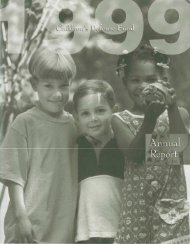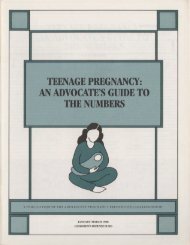child care - Digital Library Collections
child care - Digital Library Collections
child care - Digital Library Collections
You also want an ePaper? Increase the reach of your titles
YUMPU automatically turns print PDFs into web optimized ePapers that Google loves.
THE STATE OF AMERICA'S CHILDREN YEARBOOK 1998<br />
most spectacular growth, reaching 21 percent<br />
more <strong>child</strong>ren by 1997, or 1.2 million more <strong>child</strong>ren<br />
on an average day. The summer food program<br />
reached 6 percent more <strong>child</strong>ren, or 125,000<br />
more on an average day.<br />
Stability in the summer food program. The<br />
SFSP provides lunches and other meals to <strong>child</strong>ren<br />
in low-income areas during the summer, when<br />
school-based programs are not available and family<br />
food budgets are squeezed harder as a result. SFSP<br />
meals are also a central component of the full-day<br />
recreational and academic programs run by various<br />
groups, including Freedom Schools, a program of<br />
CDF's Black Community Crusade for Children.<br />
Such programs keep <strong>child</strong>ren in poor communities<br />
safe and engaged in positive activities during their<br />
out-of-school months.<br />
The 1996 welfare law reduced reimbursement<br />
rates for meals served through SFSP. However, summer<br />
food providers still receive 16-17 cents more<br />
per lunch than schools and <strong>child</strong> <strong>care</strong> centers receive<br />
for lunches they serve free to poor <strong>child</strong>ren<br />
under the school lunch program. Thus far, the lower<br />
reimbursements do not seem to have prompted significant<br />
numbers of providers to drop out of the<br />
program. In fact, instead of contracting as many<br />
had feared, the program expanded in 1997. The<br />
number of SFSP meals served rose by 8.3 million,<br />
or 7 percent-about the same rate of growth as in<br />
the previous year when the meal reimbursement<br />
rates were higher. It appears that many state agencies<br />
and nonprofit organizations, anticipating a decline<br />
in participation as a result of the welfare law<br />
changes, intensified their efforts and recruited more<br />
summer food sites into the program in 1997.<br />
Expansion funding ended for school breakfast<br />
and summer food programs. The welfare law also<br />
ended the provision of about $5 million a year to<br />
states for various outreach initiatives to expand the<br />
school breakfast program and the SFSP. Since expansion<br />
funds were first provided in 1990, they<br />
helped to finance tremendous growth in the school<br />
breakfast program. In 1977 only slightly more than<br />
20,000 schools participated; by 1987 that figure had<br />
risen to 37,000; today nearly 70,000 schools operate<br />
the program. Nearly three out ofevery four <strong>child</strong>ren<br />
attending a school with a lunch program can also<br />
receive breakfast at school (see figure 4.4). Access is<br />
even greater among low-income <strong>child</strong>ren: more than<br />
four-fifths attend a school with a breakfast program.<br />
Figure 4.4 More School Meals<br />
Growth in the school<br />
80<br />
breakfast program has<br />
70<br />
meant that almost<br />
three-fourths of 60<br />
Percentage of schools offering lunch<br />
that also offer school breakfast<br />
73%<br />
<strong>child</strong>ren eligible for 50<br />
school lunches can<br />
now start their day<br />
with a nutritious meal<br />
40<br />
30<br />
as well. 20<br />
1977 1982 1987 1992<br />
1997<br />
Source: u.s. Deportment of Agriculture, Food and Consumer Service.<br />
60 CHI L D R EN'S D E F ESE FUN D














